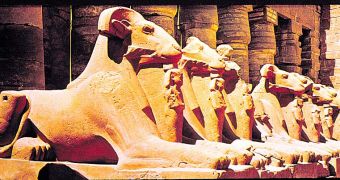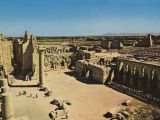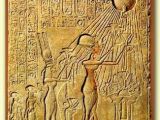The Sun had a central position in the religion of the ancient Egyptians. First, it was represented as the golden scarab, Hepri, symbolizing the becoming. Then, the hieroglyph of Sun, the proper god Ra (Re), appeared, as a circle with a point in the middle.
A first rank god, Ra personified the Sun as source of vital force, but also as a star implying light as reality and symbol. He was the supreme judge of the Universe. Worshiped in Egypt as the creator and supreme god, Ra had his religious center at Heliopolis ("The City of the Sun" in Greek, Baalbek in Egyptian), located in the south of the Nile Delta. It was also named Atum (Pesedjet in Egyptian, the reunion of the main gods).
Ra was believed to have appeared by detaching himself from the primordial chaos or that, closed between the petals of a lotus flower, raised by the waters of the beginning. He went out as the Benu (Phoenix) bird, launched in flight from the pyramidal top of a stone obelisk. That's why the obelisk covered with gold was the holiest object from the temple of Ra at Heliopolis, considered the fecundating ray of the god, hence its hazardous interpretation as a phallic symbol. Ra protected also the pyramids, considered to be solar constructions symbolizing the three ages: child at dawn (Heprer), adult at middle day (Ra) and elder at evening (Atum).
At dawn, Ra goes out of the eastern waters, greeted by the cheerful choir of the 7 sacred baboons of the monkey-god Thot, which, woken up by the first light, execute a ritual dance of joy. Then, Ra mounts into the boat of the day and floats until evening, when he gets into the boat of the night, starting to navigate to its end and supporting the repeated attacks of the dragon Apophis, getting out of the depths of the Nile of the skies. Ra is victorious each morning and, at the end of the times, he takes the shape of a fire tomcat killing Apophis.
Seeing him aged, people conspired against Ra, supreme ruler of the Earth. Ra consulted the other gods and sent the lioness-goddess Sehmet over the mortals. She is in fact The Eye of Ra, symbolizing the killing power of the Sun through her force and rage. The gods did not want to destroy the humankind. Their aim was just to dwindle the number of the humans, but in her rage and blood thirst, Sehmet did not stop the massacres. Ra then appealed to a trick, flooding her way with a brandy as red as the blood. The lioness imbibed, got drunk and forgot her rage but, when she woke up, she felt offended.
Disappointed with the people, Ra retreated on the back of Nut, the cow of the skies. Angry on Egyptians, The Eye of Ra, under the form of the lioness Tefnut, exiled herself in Nubia, a country of black people located on the middle flow of the Nile. Devoid of the Eye of Ra, the kingdom fell into chaos. The gods sent ambassadors to appease Tefnut and bring her home. The mission is accomplished by Thot. The lioness turned into the sacred cat Bastet or, as other variants say, into the cow-headed goddess of the love desire, and returned to Egypt, to everybody's delight.
The cult of Ra was very active in Egypt in all times, even when other theological tendencies manifested. In Theba, the political and religious capital of the kingdom, Ra was identified with Amon, a god sustained especially by the great priests. At the beginning, Amon was just an obscure god of the wind. His cult developed quickly at Theba during the Middle Kingdom, when he was worshiped as a god of the air and fecundity. He was represented as a human with an iron crown and ram head, and his assigned animals were the ram and the goose. The soul of Amon was represented as a ram headed Sphinx either, in the snake shaped Egyptian scepter, Kematef. Amon had great temples at Etfu, Dendera, Abydos and Karnak.
After chasing off the Hyksos (Semite invaders) in the 16th century BC, Amon turned into the supreme god of the freed kingdom. For centuries, he was imposed as the national god, sustained by his priests turned into pharaohs, who started to call him Amon-Ra. The new syncretic god achieved supplementary attributes, in his honor temples are raised in Theba and especially the Great Temple in Luxor, raised by Amenophis III, when Amon-Ra was called "king of gods, the creator of the Universe, the author of all the things, time conductor and direct master of the Sun, sky and underworld".
After the 18th dynasty of the New Kingdom, around 1,450 BC, the autonomous cult of Aton, the solar disk, worshiped as the concrete shape of Ra, emerged. It was represented as a red disk with palmed rays. Under the pharaoh Amenophis IV (1372-1354 BC), the Aton's cult officially replaced Amon-Ra's cult. It was an act of authority of the pharaoh, as priests considered the new orientation a heresy. Amenophis IV, in Egyptian Amenothes ("Amon is pleased") adopted a royal name: Akhenaton (the one over who the benevolence of Aton flows).
The introduction of the total cult of Aton was an attempt of instituting a monotheist religion (adoration of a sole god), but both the polytheist tradition (the faith in more than one god) of the Egyptians and the short rule of Akhenaton, just 18 years, hampered the universal and longstanding installation of the monotheism. Akhenaton and his wife Nefertiti built, in 1370 BC, the city of Ahet-Aton ("The Horizon of Aton"), today Tel el-Amaran, aimed to turn into the pan-Egyptian center of the cult of the new unique god. Even if the monotheist cult of Aton did not survive after the death of Akhenaton, it seems that its echoes are found in the Mosaic religion. From an hymn to Aton, one of the psalms of the Old Testament is inspired. If we think further, the monotheist religion of Judaism, Christianity and Islam have something to do with that visionary pharaoh, Akhenaton.

 14 DAY TRIAL //
14 DAY TRIAL // 

